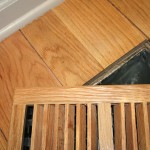 The other day I saw gaps in my wood floor and that was my indicator to stop using our bathroom exhaust fan. In winter, low moisture content in the air (relative humidity) affects not only our home interiors and furniture but our comfort and energy bills.
The other day I saw gaps in my wood floor and that was my indicator to stop using our bathroom exhaust fan. In winter, low moisture content in the air (relative humidity) affects not only our home interiors and furniture but our comfort and energy bills.
As doors open, cooking, showering and even people come and go, the RH inside your house is constantly shifting. Most people feel comfortable at a relative humidity (RH) between 40% and 60%. Green homes target that ideal range as the seasons change.
Wood is particularly susceptible to moisture changes, so I knew when I saw the gaps we had low indoor humidity (below 30%). You might even see cracks appear in your walls and ceilings. Dry-air can cause static electricity; particularly bothersome to computers and other electronics.
As the temperatures drop outside, our heating system inside must work harder to keep us comfortable. This constant heating dries out the indoor air unless other moisture sources, like bubbling soups, dishwashers and shower steam, replace it.
Bloody noses, dry skin and other breathing problems can be symptoms of low indoor humidity.
The family is most comfortable when room temperature and relative humidity are factored together. For instance, a room at 70º F combined with a relative humidity of 10% feels like 64ºF, but at 80% it feels like 71ºF.
In summer, just the opposite occurs. Relative humidity around us skyrockets. Mold can grow with RH above 70%, so using your bathroom exhaust fan on a timer is critical to managing comfortable interiors.
You can easily monitor relative humidity throughout your house using a hygrometer (moisture meter). I have them in our crawl space, on the first and second floors as well as in the attic.
I periodically check them, but especially when someone remarks that they feel too cold (or too hot).
Oddly, your indoor comfort can be maintained with a lower thermostat setting if moisture is added. Consider using a cold-mist steamer temporarily to boost the RH in rooms that are particularly dry.
I’m curious – What other signs of low indoor humidity have you seen?
